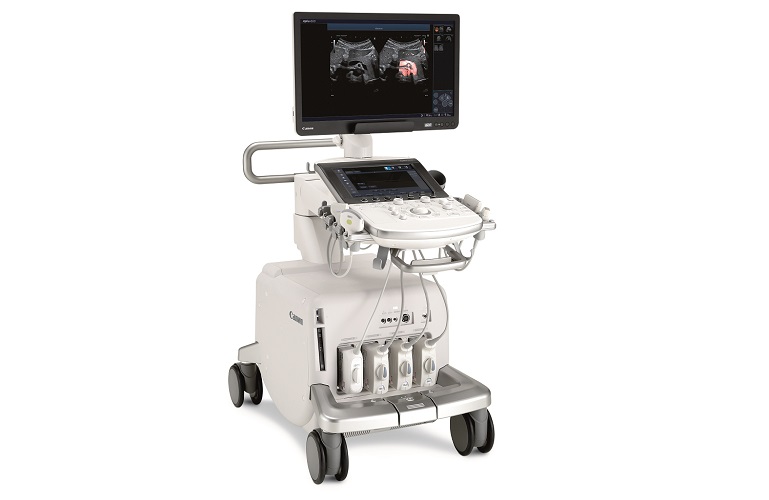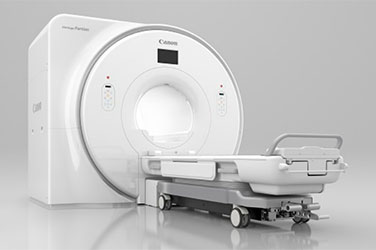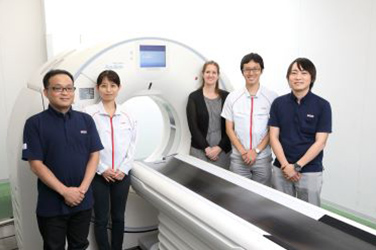Technology in ProductsDiagnostic Ultrasound System
Using Ultrasound Waves to Image
the Inside of the Body in Real-Time
Diagnostic ultrasound system deciphers “ultrasound waves,” which cannot be heard by the human ear, as signals when those waves are reflected by the boundaries of tissues. Physical features such as the shape and size of organs and the rate of blood flow are rendered as images to aid in diagnosis. Ultrasound requires no radiation exposure and it is also safe, painless, and able to be performed repeatedly. Therefore, it is widely used as a diagnostic tool for a wide range of purposes, from routine check-ups to more thorough examinations, as well as a guide for treatment and in follow-up checks.
February 16, 2023

How Diagnostic Ultrasound System Works
Ultrasound waves cannot be heard by the human ear. Sound has wave properties, and ultrasound diagnostic equipment uses ultrasound waves, to produce images of the inside of the body. Ultrasound waves are transmitted inside the body, and the waves reflected back by organs and tissues (echoes) are received and used to create images based on this information.
Read More
Canon’s Ultrasound Technology
A Fine, Thin Ultrasound Beam is Transmitted and Received, Allowing the Acquisition of Fine, Clear Images
Because of their unique properties, reflected ultrasound waves become weaker as they travel longer distances. This posed an issue for engineers since areas deep inside the body could not be clearly imaged. However, Canon has created a technology that combines ultrasound waves with two different waveforms, transmitting them simultaneously. This produces new ultrasound waves that reach deeper inside the patient's body. In addition, the received ultrasound beam is thinner and more precise, thus resulting in ideal-quality images.
【Video】 Developed a technology that combines two different waveforms of ultrasound waves and transmits them simultaneously
*In order to view videos, it is necessary to consent to the use of cookies by our website. If the videos are not displayed, please click the "Cookie Settings" and accept cookies.
If the beam received by the transducer is too wide, it will result in a lot of unnecessary information from areas of the body other than the one being examined. To prevent this, Canon has used semiconductor processing technology to vertically divide the sensor into 3 sections. The timing with which a beam is received by each section is staggered, successfully shrinking the area from which the beam is received. Moreover, a high-speed receiving circuit allows the acquisition of more than 100 images per second. This technology provides clear images of areas both near the surface of the skin and deep inside the body, and has greatly expanded the range of areas that can be examined. This technology is used in internal medicine, obstetrics and gynecology, as well as a wide range of other fields such as orthopedic surgery.

A wider beam results in more unnecessary information

Information on the area being examined is received with a fine, thin beam
Unique SMI Technology Depicts Blood Flow in Blood Vessels, Which Previously Could Not be Visualized
In the past, when slow blood flow at areas such as the kidneys or liver was viewed with diagnostic ultrasound system, unwanted noise was received and the system failed to yield clear images. When the noise was removed by image processing, important structures such as fine blood vessels were lost. However, when Canon’s unique Superb Micro-vascular Imaging (SMI) method of imaging blood flow processes the received signal, it removes only the unwanted noise while leaving intact images of the fine, slow blood flow. In the past, blood flow in blood vessels smaller than 0.1 mm could not be seen even when using contrast media. With Canon’s technology, that blood flow can now be seen. This makes possible the early diagnosis of such conditions as cancer and rheumatoid arthritis, and helps medical professionals determine the ideal treatment strategy.
【Video】 Canon’s unique Superb Micro-vascular Imaging (SMI) method of imaging blood flow
*In order to view videos, it is necessary to consent to the use of cookies by our website. If the videos are not displayed, please click the "Cookie Settings" and accept cookies.






